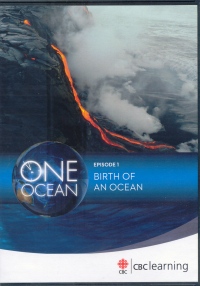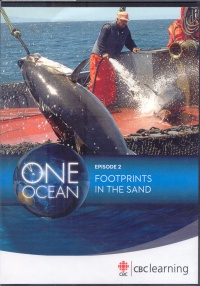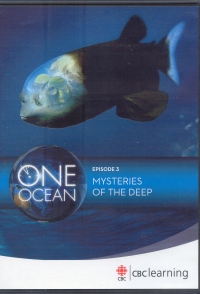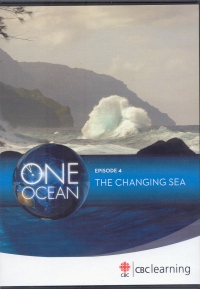| ________________
CM . . .
. Volume XVIII Number 41. . . .June 22, 2012
One Ocean is a four episode series that aired on The Nature of Things with David Suzuki. Each episode contains four chapters about ten minutes in length. The cinematography is of the highest quality and is complemented by skillfully executed modeling/animation. An international array of scientists shares their expertise. Underwater images include those shot in the deepest ocean trenches where scientists and viewers see species never before documented. The series is accompanied by a rich website and a Teacher Resource Guide prepared by five educators from Ontario, Nova Scotia and British Columbia. The Guide includes reproducible unit overviews, activities and lessons for each episode, designed for one of two grade groupings: 8-10 or 11-12. The lessons draw upon the videos, themselves, and are integrated with the website www.cbc.ca/oneocean. The website provides students with an opportunity to meet the experts involved in the series, view video extras and listen to interviews with the experts featured in each of the episodes and subscribe to podcasts. The website utilizes software such as Google Ocean technology that requires downloading of plug ins. Students can play educational games (more plug ins required) about the biosphere, access a Time Machine that documents prehistoric life that emerged millions of years ago in named geologic eras, discover the history of underwater exploration, or login and make One Ocean pledges to take actions that will help address issues affecting the health of the ocean. In brief, the website has the potential for many hours of informational and entertaining engagement. Episode 1: Birth of an Ocean would be more accurately named Birth of an Ocean and Evolution of Life. It begins with a visit to a volcano in Ethiopia with geologist Nick Eyles. When the earth was still a molten mass some 4.5 billion years ago, superheated steam emerged from the earth, condensed and fell as rain. Gradually, the ocean was born. In Australia, palaeontologist Peter Ward discusses the origin of life in the ocean as he describes stromatolites, a bacteria that combined with sand to form rock like structures that once covered the ocean floor. Anaerobic life was supplemented by pigmented cells that, through photosynthesis, produced oxygen as a by product. Oxygen in the ocean and the air became crucial to survival of new forms of life. In the second chapter, “Oasis of the Deep,” ocean biologist Verena Tunnicliffe describes hydrothermal vents that, despite providing unimaginably hostile conditions, prove to be teaming with well adapted life forms from bacteria to tube worms and crabs. The importance of oxygen is demonstrated by explanations of the causes of four of five mass extinctions when most of life died off due to low levels of oxygen in the oceans. While extinction is the fate of all species, why did some animals survive the last major extinctions? “Living Fossils” features the nautilus, a creature that has survived some 500 million years. It is believed to have survived the last great extinction caused by an asteroid strike that burned the surface waters and the life it supported by the fact that predation had forced it to move to greater depths untouched by the calamity above. The final chapter, “From Water to Land,” begins on Ellesmere Island in the Canadian Arctic where vertebrate zoologists uncover fossils of Tiktaalik, the 375 million year old “missing link” that was half finned fish and half four-footed animal. This fish to tetrapod developed in flood plains and was able to survive in water and move on land. This adaptation helped it to elude predators and led to the evolution of land animals. From a thematic perspective, this introductory episode is the most ambitious and least unified in the series. Episode 2: Footprints in the Sand raises concerns about the impact of humans on marine life and ecosystems. The Mediterranean Sea has supplied food for humans for millennia. Overfishing was a problem even in Roman times, but the situation is even more severe today. In the Nile Delta, wetlands that have been separated from the sea by urban development are choked by vegetation, causing oxygen levels to plummet and marine animals to vanish. Marine deserts or dead zones appear to be growing in the Gulf of Mexico and hundreds of other locations where human sewage and fertilizer runoff feeds algae blooms that later decompose on sea beds, consuming oxygen and leaving the water uninhabitable by other marine life. Human settlement along coasts causes the loss of habitat for spawning fish and other creatures. Since ninety percent of marine species spend part of their life in the coastal zones, the importance of preserving the coastal zone ecosystems is crucial to survival of sea life. Some efforts to practice more sustainable harvesting of shellfish are cause for hope. More positive is the final chapter, “Restoring Marine Ecosystems,” that documents scientific studies in New Zealand that discovered that the creation of marine reserves could transform depleted ecosystems in a relatively short time. They learned that a “No Take” approach outlawing all fishing, recreational as well as commercial, is the only way to attain success. With 32 marine reserves, New Zealand is the leader in demonstrating that recovery of the coastal ocean ecosystems is possible if human behaviour can be managed. This episode is perhaps the best of the lot, despite having a cryptic title. Episode 3: Mysteries of the Deep provides some of the most exciting zoological content. With only about five percent of the deep sea explored, it remains the last frontier on the planet. Viewers join research expeditions mapping and surveying the life on the Marianna Arc where the Philippine tectonic plate collides with the Pacific plate. Remote submersibles, like Jason 2, dive to 400 m, exploring steam vents, sulphur plumes and the unique biotic communities that differ from vent to vent. Sampling, collecting, and photographing are all part of the work. Closer to Canada, scientists use the latest submersibles to explore the National Marine Sanctuary off the coast of California. Marine ecologist Bruce Robinson describes some of the most unusual life forms found in the deep ocean, below 600 m. Here, light from above does not penetrate, but some life forms create their own light by bioluminescence. Creatures like the vampire squid that were previously only know to scientists from dead specimens captured by deep sea fishers can now be observed in their natural habitat. Thus mysteries of the deep are explained. Deep sea fish species have been unsustainably harvested since the late twentieth century resulting in the collapse of the fisheries. The orange roughy is presented as a case study. Scientists dating mature fish by analyzing their bones, much like a forester dates a tree by counting growth rings, discovered that specimens were up to 100 years of age, indicating a very slow reproduction and maturation rate. Evidence now shows that knowledge that applies to species living near the surface may not hold true for those that live 1000 m below the surface. Destruction of habit by trawlers that scrape the ocean bottom is exacerbating the problems of overfishing. The episode ends with a chapter featuring the Super Falcon, a new generation of submersibles that can dive to a depth of 300 m, but, unlike earlier submersibles and remote controlled robotic devices, it is quiet and uses laser probes that emit a small amount of light and is thus less disruptive to the inhabitants of the ocean. Episode 4: The Changing Sea begins on the west coast of Vancouver Island where hake fishers are seeing fewer hake and a lot more Humboldt squid, a voracious predator native to Mexican waters. Scientists speculate this change is due to two causes: the loss of the squids’ natural predators like tuna and other large fish due to overfishing, and warming of the ocean in conjunction with global warming and a persistent El Nino climate cycle. Fish stocks are moving poleward as the water warms, thus bringing invading species into new territory where the original plants and animals may not be able to withstand the changes. Chapter two, “The Arrhythmic Ocean,” returns to a concept introduced in episode one: the importance of oxygen to life sustaining oceans. Changing rhythms in the ocean are creating dead zones like the one off the coast of Oregon that reoccurs every year. In the subarctic, oxygen levels in water samples from 500 m depth reveal huge drops in the amount of oxygen at depth. The cause is explained by chemistry as glacial melt water introduces too much fresh water to the Arctic Ocean, interfering with the natural ventilation of the ocean whereby oxygen absorbed at the surface sinks to depth. Fresh water, lighter than the salty water below, cannot sink. While reduced oxygen levels spells disaster for life in the seas, the hazards are compounded by increased acidification of the oceans. About one quarter of the carbon dioxide in the atmosphere is absorbed into the ocean where it is converted into carbonic acid. Accompanying drops in calcium levels make it impossible for shelled creatures to thrive. Researchers estimate that global warming will contribute to a 200% increase in ocean acidity levels this century. Some species of zooplankton are small shelled creatures. In corrosive waters, they will not be able to survive, and this will have a major impact on the food chain. Mass extinctions seem headed our way. Scientists examining waters in naturally occurring vents filled with carbon dioxide can speculate on the lack of biodiversity that the ocean can sustain in ninety years when the chemical balance of the general ocean is anticipated to reach comparable levels. The ocean, the cradle of life and home to an estimated eighty percent of the life on the planet, is changing rapidly. Scientists ponder the question, How will our generation be remembered by future generations? One Ocean can be used in classes as diverse as geography, science, and biology. Much of the content of the accompanying website, such as biosphere themed games, is geared to students in the lower range of the recommended viewership (grades 8-10) but could be used with a slightly younger audience as well. One Ocean: Episode 1: Birth of an Ocean - Recommended.
Val Ken Lem is a librarian at Ryerson University in Toronto, ON.
To comment
on this title or this review, send mail to cm@umanitoba.ca.
Copyright © the Manitoba Library Association. Reproduction for personal
use is permitted only if this copyright notice is maintained. Any
other reproduction is prohibited without permission.
NEXT REVIEW |
TABLE OF CONTENTS FOR THIS ISSUE
- June 22, 2012.
AUTHORS |
TITLES |
MEDIA REVIEWS |
PROFILES |
BACK ISSUES |
SEARCH |
CMARCHIVE |
HOME |



